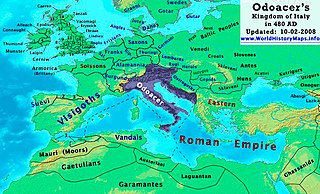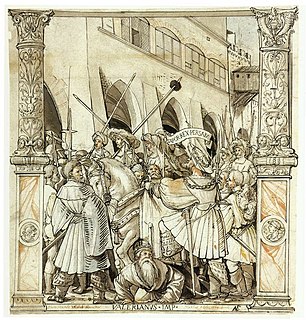The 120s decade ran from January 1, 120, to December 31, 129.

Year 480 (CDLXXX) was a leap year starting on Tuesday of the Julian calendar. At the time, it was known as the Year of the Consulship of Basilius without colleague. The denomination 480 for this year has been used since the early medieval period, when the Anno Domini calendar era became the prevalent method in Europe for naming years.
AD 45 (XLV) was a common year starting on Friday of the Julian calendar. At the time, it was known as the Year of the Consulship of Vinicius and Corvinus. The denomination AD 45 for this year has been used since the early medieval period, when the Anno Domini calendar era became the prevalent method in Europe for naming years.
AD 58 (LVIII) was a common year starting on Sunday of the Julian calendar. At the time, it was known as the Year of the Consulship of Caesar and Messalla. The denomination AD 58 for this year has been used since the early medieval period, when the Anno Domini calendar era became the prevalent method in Europe for naming years.

AD 80 (LXXX) was a leap year starting on Saturday of the Julian calendar. At the time, it was known as the Year of the Consulship of Augustus and Domitianus. The denomination AD 80 for this year has been used since the early medieval period, when the Anno Domini calendar era became the prevalent method in Europe for naming years.

AD 100 (C) was a leap year starting on Wednesday of the Julian calendar. In the Roman Empire, it was sometimes referred to as year 853 ab urbe condita, i.e., 853 years since the founding of Rome in 753 B.C. The denomination AD 100 for this year has been used since the early medieval period, when the Anno Domini calendar era became the prevalent method in Europe for naming years.

Year 543 (DXLIII) was a common year starting on Thursday of the Julian calendar. The denomination 543 for this year has been used since the early medieval period, when the Anno Domini calendar era became the prevalent method in Europe for naming years.
The 140s decade ran from January 1, 140, to December 31, 149.

Year 422 (CDXXII) was a common year starting on Sunday of the Julian calendar. At the time, it was known as the Year of the Consulship of Honorius and Theodosius. The denomination 422 for this year has been used since the early medieval period, when the Anno Domini calendar era became the prevalent method in Europe for naming years.
Year 165 (CLXV) was a common year starting on Monday of the Julian calendar. At the time, it was known as the Year of the Consulship of Orfitus and Pudens. The denomination 165 for this year has been used since the early medieval period, when the Anno Domini calendar era became the prevalent method in Europe for naming years.

Year 512 (DXII) was a leap year starting on Sunday of the Julian calendar. In the Roman Empire, it was known as the Year of the Consulship of Paulus and Moschianus. The denomination 512 for this year has been used since the early medieval period, when the Anno Domini calendar era became the prevalent method in Europe for naming years.

Year 610 (DCX) was a common year starting on Thursday of the Julian calendar, the 610th year of the Common Era (CE) and Anno Domini (AD) designations, the 610th year of the 1st millennium, the 10th year of the 7th century, and the 1st year of the 610s decade. The denomination 610 for this year has been used since the early medieval period, when the Anno Domini calendar era became the prevalent method in Europe for naming years.

Year 240 (CCXL) was a leap year starting on Wednesday of the Julian calendar. At the time, it was known as the Year of the Consulship of Sabinus and Venustus. The denomination 240 for this year has been used since the early medieval period, when the Anno Domini calendar era became the prevalent method in Europe for naming years.

Year 280 (CCLXXX) was a leap year starting on Thursday of the Julian calendar. At the time, it was known as the Year of the Consulship of Messalla and Gratus. The denomination 280 for this year has been used since the early medieval period, when the Anno Domini calendar era became the prevalent method in Europe for naming years.

Year 250 (CCL) was a common year starting on Tuesday of the Julian calendar. At the time, it was known as the Year of the Consulship of Traianus and Gratus. The denomination 250 for this year has been used since the early medieval period, when the Anno Domini calendar era became the prevalent method in Europe for naming years.

Year 260 (CCLX) was a leap year starting on Sunday of the Julian calendar. At the time, it was known as the Year of the Consulship of Saecularis and Donatus. The denomination 260 for this year has been used since the early medieval period, when the Anno Domini calendar era became the prevalent method in Europe for naming years.

Year 266 (CCLXVI) was a common year starting on Monday of the Julian calendar. At the time, it was known as the Year of the Consulship of Gallienus and Sabinillus. The denomination 266 for this year has been used since the early medieval period, when the Anno Domini calendar era became the prevalent method in Europe for naming years.

Year 337 (CCCXXXVII) was a common year starting on Saturday of the Julian calendar. At the time, it was known as the Year of the Consulship of Felicianus and Titianus. The denomination 337 for this year has been used since the early medieval period, when the Anno Domini calendar era became the prevalent method in Europe for naming years.

Year 467 (CDLXVII) was a common year starting on Sunday of the Julian calendar, the 467th Year of the Common Era (CE) and Anno Domini (AD) designations, the 467th year of the 1st millennium, the 67th year of the 5th century, and the 8th year of the 460s decade. At the time, it was known as the Year of the Consulship of Pusaeus and Iohannes. The denomination 467 for this year has been used since the early medieval period, when the Anno Domini calendar era became the prevalent method in Europe for naming years.
A calendar era is the period of time elapsed since one epoch of a calendar and, if it exists, before the next one. For example, it is the year 2022 as per the Gregorian calendar, which numbers its years in the Western Christian era.













